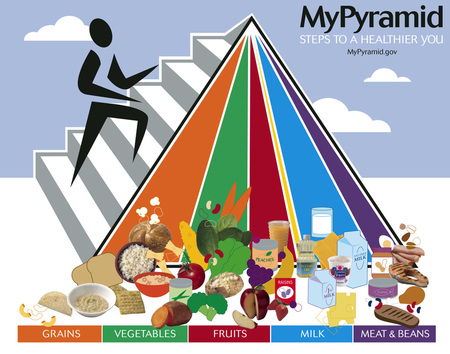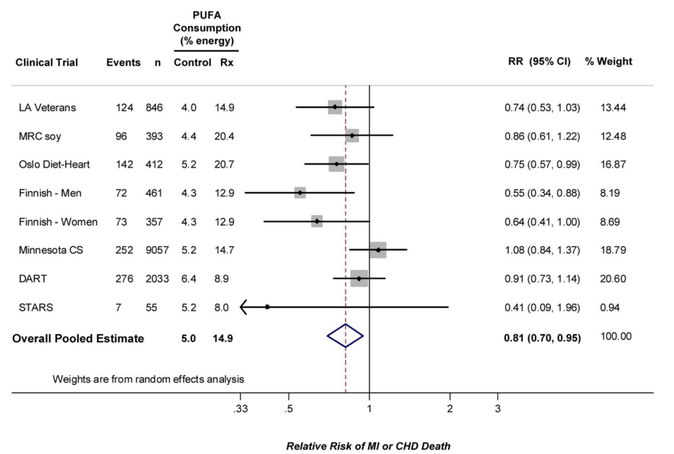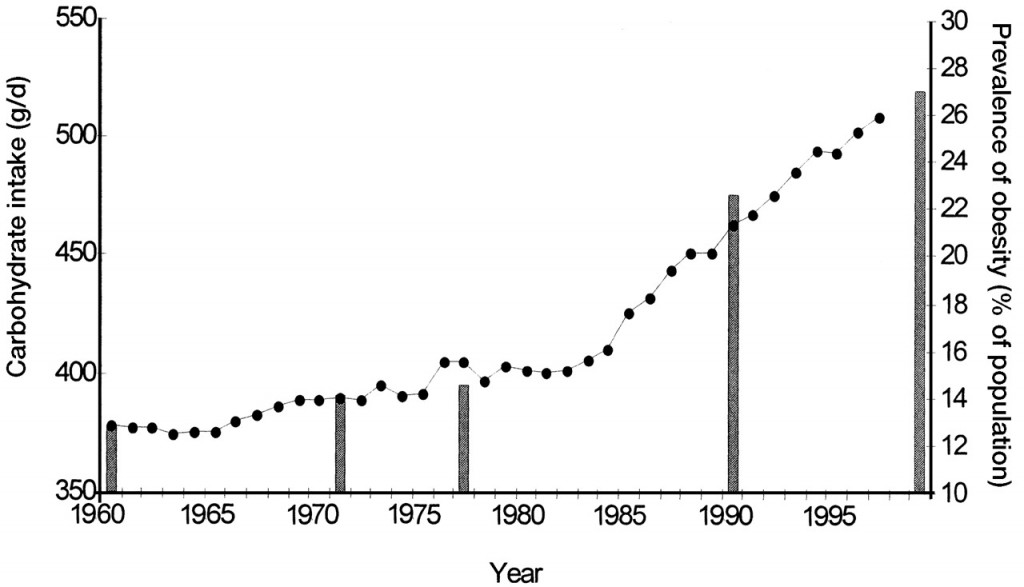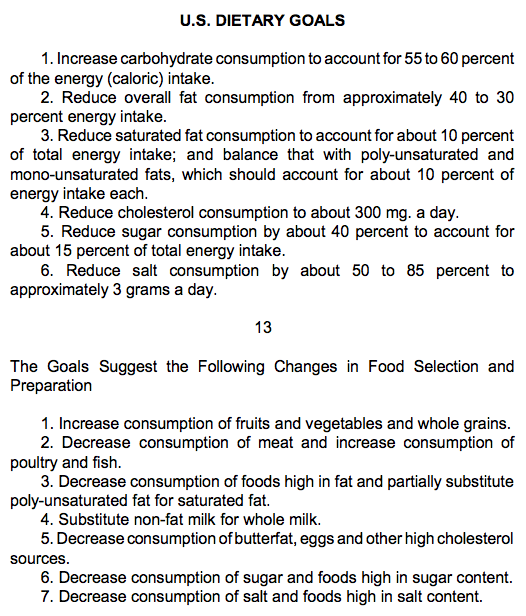For the past 15 years, Americans have done a tremendous job of nearly achieving the current goal of no more than 10% of their calories coming from saturated fats. However, due to the less than satisfactory reduction in heart disease rates, these guidelines suggest we should eat even less:
"given that in the US population 11-12 percent of energy from SFA [saturated fatty acids] intake has remained unchanged for over 15 years, a reduction of this amount resulting in the goal of less than 7 percent energy from SFA should, if attained, have a significant public health impact"
For a 2,000 calorie diet, this means eating about 15 grams of saturated fat a day, a value that seems unattainable for the omnivore. The equivalent of a glass of milk and two 6 ounce pieces of chicken breast; or one 9 ounce piece of steak:
Since the 1950s, there have been a relatively small number of large, long-term clinical trials examining the potential benefits of decreased saturated fats in the diet as a primary focus. All major trials since 1966 are listed here. Some took place in mental institutions, some were not randomized, and some also involved major confounding interventions such as weight loss, exercise, or increased fruit and vegetable consumption. Some show benefits to replacing saturated fats with polyunsaturated fats, while others do not.
If we were to focus on the largest (i.e. > 100 subjects), randomized, most famous trials ever done lasting longer than 1 year, we are left with very few to assess that meet the following 2 criteria:
1) The only significant intervention involved a reduction in fat and saturated fat and an increase in polyunsaturated fats
2) They ask the question: does this diet reduce heart disease? (defined as heart attacks or death from heart disease)
Listed in reverse chronological order:
Women’s Health initiative (2006) – 48,835 women, 8 years, no significant difference between intervention and control.
Diet and Reinfarction trial (1989) – 2,033 men, 2 years, no significant difference between the groups given and not given fat and fiber advice. No significant differences in ischaemic heart disease between intervention and control (intervention was only advice in this trial)
Minnesota Coronary Survey* (1989) – 4,393 men and 4,664 women, double-blind, 4 years, no significant reduction in cardiovascular events or total deaths from the treatment diet
Los Angeles Veteran’s Trial* (1969) – 846 subjects, up to 8 years, non significant difference in primary endpoints – sudden cardiac death or myocardial infarction. More non-cardiac deaths in experimental group, resulting in near identical rates of total mortality
Oslo Heart Study (1968) – 412 men, 5 year, slight decrease in CHD with intervention. Many dietary interventions accompanied the low saturated fat diet. When stratified by age, the results were significant only in subjects younger than 60.
* Double blind
A full list of all the trials done supporting and refuting the saturated fat-heart-disease relationship, and a more in depth description of each, can be found here. There are many others that did not meet the criteria I defined above. (Note: The finnish Mental Hospital Trial did not make the cut, since it was not randomized.)
Meta-analyses
If we instead focus on the recent meta-analyses of clinical trials testing this relationship, the majority have failed to elucidate a benefit associated with a low saturated fat diet:
- In 2010, Ramsden et al. published a meta-analysis of randomized clinical trials, including trials where polyunsaturated fats (PUFAs) were increased in place of saturated fats (SFAs) and/or trans fatty acids (TFA), and non-fatal heart attacks, Coronary heart disease-related deaths, and/or total deaths were reported. In the nine studies included, there was a non-significant increased pooled risk of 13% for n-6 PUFA intake (RR=1.13, CI: 0.84, 1.53) and a decreased risk of 22% (RR=0.78, CI: 0.65, 0.93) for mixed n-3/n-6 PUFA diets. In other words, increasing polyunsaturated fats in the diet provides no benefit, and may be harmful according to this study.
- Also in 2010, Mozaffarian et al published a systematic review and meta-analysis of randomized clinical trials investigating the effects of increasing PUFAs in place of other nutrients. Among the seven studies included, an overall pooled risk reduction of 19% (RR= 0.81, CI=0.83-0.97) was observed for each 5% of energy of increased PUFA in the diet.
- In 2009, Mente et al. published a systematic review of the randomized clinical trial (RCT) evidence that supports a causal link between various dietary factors and coronary heart disease The pooled analysis from 43 RCTs showed that increased consumption of marine omega-3 fatty acids (RR=0.77; 95% CI: 0.62-0.91) and a Mediterranean diet pattern (RR=0.32, 95% CI: 0.15-0.48) were each associated with a significantly lower risk of CHD. Higher intake of polyunsaturated fatty acids or total fats were not significantly associated with CHD, and the link between saturated fats and CHD received a Bradford Hill score of only 2 (out of a maximum score of 4), signifying weak evidence of a causal relationship.
- Also in 2009, the Cochrane Collaboration, an international not-for-profit organization, published a meta-analysis of clinical trials that either reduced or modified dietary fat for preventing cardiovascular disease. Twenty-seven studies met the inclusion criteria, and no significant effect on total mortality (RR = 0.98, 95% CI: 0.86-1.12) or cardiovascular mortality (RR = 0.91, 95% CI: 0.77-1.07) was found between the intervention and control groups. They concluded by saying: “It is not clear whether a low fat diet, a modified fat diet, or a combination of both is most protective of cardiovascular events.”
Inclusion of male and female Finnish data separately further raises concern since it clearly exaggerates the apparent cardio-protective effect of PUFAs demonstrated in this meta-analysis. Excluding the Finnish data from their pooled analysis would diminish the observed results and elicit a null finding, since all other included studies apart from the Oslo heart study (RR=0.75, CI 0.57-0.99) were null:
Extra Weight Loss in High Saturated Fat Group Adds Complexity:
To further complicate things, the diets that are typically characterized by high amounts of saturated fats seem to result in the most weight loss. When researchers compare a calorie unlimited, low-carb, high saturated fat diet to a traditional low calorie, low-fat diet, the low carb group generally -- but not always -- loses more weight. With few exceptions, their good cholesterol levels go up and their triglycerides go down. Despite having an unlimited calorie budget and often consuming 3x the amount recommended saturated fats, the subjects tend to lose more weight and rarely increase their bad cholesterol levels. ( For more on this and a list of all major clinical trials, see carbohydrate-restricted diets.)
Recommending such low levels of saturated fat, primarily found in meats, may have unintended consequences.
Since saturated fats are mainly found in protein-dense animal products, decreasing saturated fat intake to very low levels by definition encourages low-protein diets, which seem to be less effective for weight loss and satiety (feeling full). Such a drastic recommended decrease in one nutrient of our diets (fats) can lead to a large increase in another. This unfortunate story has played out over past 30 years with carbohydrates. Especially the refined ones:
By looking at this figure, one can't help but ask: What happened in 1977?
Maybe it is time to try something new.





 RSS Feed
RSS Feed
